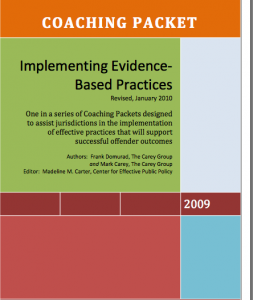Dealing with the whole person in sentencing: Part 10
If you follow the comments of governors and other state policy makers these days, it appears that they have signed on to the notion that drug courts are the answer to prison overpopulation, high crime rates, and increased recidivism (and that may be the short list). In reading about their support for drug courts, I am cheered by their adoption of an important innovation that I along with others pioneered over twenty years ago. And I am disheartened by their misunderstanding of the significance and applicability of drug court to one and all criminal offenders.
As described by Dr. Doug Marlow, at the 18th Annual NADCP Conference in Nashville (see: NADCP argues for Evidence-based tracks), most drug offenders are not drug dependent and shouldn’t be part of an intensive drug court program. In fact, according to Dr.Marlow, 60 to 80% of drug offenders do not need a drug court’s intensive treatment. The majority of criminal offenders need to be treated as a whole person (not just a drug abusing person). As tempting as it may be to lock onto drug treatment as a silver bullet that works with all offenders, it isn’t an effective or cost- efficient tool for most criminal offenders (or even most drug offenders).
However that shold not conclude our analysis. If you look at the scientific literature on evidence based sentencing practices (click on image on the left,for a brief, comprehensive description of “Evidence Based Practices”), you’ll find that medium to high risk offenders have substantial criminogenic needs that need to be addressed, even if they’re not drug related.
“Criminogenic Needs” are functional impairments that if not treated, will increase the risk of further criminality. The top four such needs are a history of anti-social behavior, anti-social personality factors, anti-social cognitions/attitudes, and anti-social peers.Surprisingly, drug abuse is a second tier criminogenic need that only becomes a central concern if the offender is truly drug dependent or addicted., Otherwise, substance abuse treatment ranks behind such second tier criminogenic needs such as family and/or marital stressors, employment and/or education deficiencies, and lack of pro-social leisure activities.
In practical terms, it appears that we over-treat drug abuse and pay too little attention to cognitive behavioral needs and rehabilitative therapies that have proven success in dealing with them. In essence what Dr. Marlowe and his scientific brethren have been telling us is Drug Court is not the answer to most offenders’ crimonogenic needs (although the better drug courts do not neglect them). Certainly drug courts can be modified (as Dr. Marlow suggests) to deal with the majority of criminal offenders, whose drug usage is not a primary criminogenic need. But it should be clear to all, that doing so may negatively impact drug courts and appropriate participants As the old saw goes, if you just treat a criminal offender’s drug abuse, you might just create a healthier criminal. Better to deal with the whole person, in an evidence-based sentencing system, where their individual levels of risk and need are determined, and the appropriate supervision and treatment responses applied to them..


